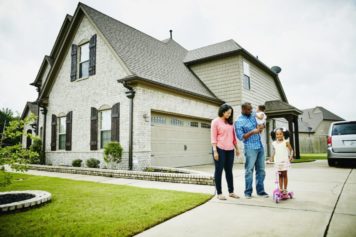
In 2016, only 14 percent of homes for sale in 30 of the U.S. largest cities
were affordable for Black middle-class families. (Photo by Phillip Spears/DigitalVision /Getty Images)
Less than five percent of homes for sale in Denver, Los Angeles, Phoenix, Portland, San Diego and San Francisco were affordable for middle-class African-American and Hispanic families in 2016, according to a new report by Redfin, a web-based real estate database and brokerage firm.
The report, published on May 31, examined the dwindling number of affordable homes in the U.S. housing market and its effects on the ever-widening homeownership gap between white and nonwhite American families. For one, the study showed that just 14 percent of homes in the U.S.’s 30 largest metro cities were affordable for families earning the median income for Black households, while 18 percent were affordable for people earning the median income for Latino households.
The study noted that while the percentage of affordable homes across the 30 metro cities declined by almost the same amount for white families as it did for African-American and Latino families, the latter groups were hit particularly hard due to their already low rates of homeownership. In the first quarter of 2017, more than 70 percent of white families were homeowners, compared to just 43 percent of African-Americans and 47 percent of Latino families, according to the report.
This, coupled with the decline of available homes for sale, the struggle for new construction to keep up with buyer demand, sluggish income growth and the 18-percent increase in rents over the past five years, have essentially resulted in Blacks and Latinos being priced out of the housing market in several cities across the U.S.
“[America] is at risk of becoming a renter nation in our largest and wealthiest metros, where middle-class and working-class families are increasingly unable to achieve the American dream of homeownership,” the report read. “Without policy change, fast-growing U.S. cities will continue to cement a slow-growth economy where people decline to move to where the good jobs are because it’s too expensive to live there.”
After analyzing median household incomes by race and ethnicity for each metropolitan statistical area, or MSA, from the American Community Survey (2012-2015), researchers concluded that St. Louis, Mo., was the only market out of the 30 that became more affordable for both middle-class Black and Latino households.
The study also found that the racial gap in housing affordability was largest in Minneapolis, Minn., where the average white family could afford 66 percent of the homes for sale, compared to just 5.2 percent and 24.8 percent for middle class African-American and Latino households, respectively. Meanwhile, Denver, Colo., had the smallest racial gap; an average middle-class white family there could afford 8.3 percent of the homes for sale, while less than 2 percent of available homes were affordable to families earning the median income for African-American and Latino households, according to the study.
Houston, Texas, experienced the largest decline in the number of residential listings affordable to middle-class families. The study showed that in 2016, only 26.4 percent of Houston-area homes were affordable to the middle class — that’s less than half of the 54.8 percent that were affordable there in 2012.
This downward trend in the number of affordable listings (by 20 percent or more) was consistent in 19 of the 30 cities examined, including Miami, Los Angeles, Atlanta and Las Vegas.
“The share of affordable listings was mostly flat over the past four years, down just 0.1 percent overall,” according to the study. “Baltimore [down 0.6 percent] and Washington D.C., down 0.8 percent had the second- and third-smallest declines in affordability, respectively.”
To help combat the issue of housing affordability among middle-class, nonwhite families, researchers suggested that federal and state governments reward communities that switch to inclusionary zoning methods by offering them infrastructure investments to enhance their neighborhoods. They also recommended changes to current tax policies like the Mortgage Interest Deduction (MID), which benefits already wealthy homeowners who itemize their tax returns.
“With policy changes like these, the U.S. can turn the tides on housing affordability for everyone while keeping our cities both economically and racially diverse,” the report concluded.

